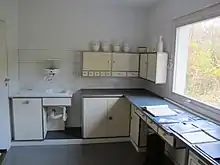Benita Koch-Otte
Benita Koch-Otte (23 May 1892 – 26 April 1976), born Benita Otte, was a German weaver and textile designer who trained at the Bauhaus.
Benita Koch-Otte | |
|---|---|
 Benita Koch-Otte, photographed by her husband, Heinrich Koch, in the 1920s | |
| Born | 23 May 1892 Stuttgart, Germany |
| Died | 26 April 1976 (aged 83) Bielefeld, Germany |
| Spouse | Heinrich Koch (m.1929–1934, his death) |
Life and work
Benita Otte was born on 23 May 1892 in Stuttgart, Germany. Otte's father was a chemist.[1]
After attending Lyceum in Krefeld, Otte taught drawing and physical education in Uerdingen. In 1920, she enrolled at the Bauhaus in Weimar where she studied in the studio's weaving workshop. She was later employed in the workshop, working closely with Gunta Stölzl. Otte left the Bauhaus in 1925.[2]

Although she worked primarily as a weaver, Otte, on a number of occasions, produced work beyond the medium. Notable among this work is Otte's design for the kitchen of the 1923 Haus am Horn in Weimar, which inspired Margarete Schütte-Lihotzky's 1926 Frankfurt kitchen.[3] [4]
After leaving the Bauhaus, Otte served as head of the weaving workshop at the Kunstgewerbeschule Burg Giebichenstein, a vocational arts college in Halle, now the Burg Giebichenstein University of Art and Design.[5] In 1929 she reunited with the Czech photographer Heinrich Koch (1896–1934) who studied with Otte at the Bauhaus; Benita married Koch later that year.[2]
A number of former students and teachers from the Bauhaus went to work at the school, including: Gerhard Marcks, the Rector from 1928 until 1933; Hans Wittwer, who ran the Architecture department; Marguerite Friedländer and Erich Consemüller. Following the Nazi rise to power in 1933, Koch-Otte and other staff considered avant-garde were dismissed from the school.[5]
Koch-Otte and her husband then moved to Prague. Heinrich Koch died in an accident in 1934, and Benita returned to Germany, where she taught at the Bodelschwingh Foundation Bethel (German:Bodelschwinghsche Stiftungen Bethel), a psychiatric hospital in the Bethel district of Bielefeld. At the hospital, Koch-Otte ran weaving workshop for patients.[2][6] She worked at the foundation until her 1957 retirement.
Death and legacy
Koch-Otte died on 26 April 1976 in Bielefeld, Germany.[1]
Former students of Benita Koch-Otte include Trude Guermonprez,[7] among others.
Benita Koch-Otte Street (Benita-Otte-Straße) in Erfurt, Germany is named after her.
See also
References
- Strotdrees, Gisbert. "Benita Koch-Otte". Westfälische Biographien. Retrieved 23 May 2021.
- Bauhaus100. Bentia Koch-Otte. Retrieved 15 May 2019
- Markgraf, Monika (ed.) (2018) Bauhaus World Heritage Site (English edition). Leipzig: Spector Books
- Blümm, Anke; Ullrich, Martina (eds) (2019) Haus am Horn. Munich: Hirmer Verlag / Klassik Stiftung Weimar
- Dolgner, Angela (ed.) (1993) Burg Giebichenstein. Die hallesche Kunstschule von den Anfängen bis zur Gegenwart; Staatliche Galerie Moritzburg, Halle, 20. März bis 13. Juni 1993 ; Badisches Landesmuseum, Karlsruhe, 25. Juni bis 12. September 1993. Halle: Staatliche Galerie Moritzburg
- Krause, Reinhard (2018-10-13). "Die Bauhaus-Weberin Benita Koch-Otte". Architektur, Design & Interior - AD Architectural Digest (in German). Retrieved 2019-03-28.
- "Trude Guermonprez". Cooper-Hewitt, National Design Museum Collection. Cooper-Hewitt, National Design Museum. Archived from the original on 2016-03-03. Retrieved March 10, 2021.